| Rbt. Sps. /// How to Make a Large Scale Sculpture, 13:65 min, digitally transferred Hi-8, 2008 |
Driving across the vast countryside of the United States, one can note the overall sparseness and lack of ornamentation in this country. What is most commonplace is the occasional barn or house surrounded by open space. In the most rural regions (especially in the Southern United States) these usually stark barns and houses can be found surrounded with surpluses of nearly very material good imaginable. These materials include scrap building materials, firewood, retired automobiles, old signs, and furniture- in other words, junk. The overall abundance of goods due to generations of American prosperity has caused nearly every object to be taken for granted and viewed as a commodity. However, in rural America, junk is still a fixture of this environment partially to apathy and partially due to the dying, yet still present depression era mentality of “waste not want not”. The potential of material goods is something that will never truly go away, and the common practice of stockpiling is nearly a canon of rural America. In creating my sculpture, Phacian, I was highly inspired by this sentiment. In addition the practice of hoarding materials, I was influenced by the predominately vacant countryside itself, as a place to become a forum for my work. As previously stated, the majority of the rural United States is lacking in any type of formal decoration, and the bulk of this rural population is not concerned or interested in art. However, traces of art and craft do exist in the American countryside. While on a driving on trip over this past spring, I discovered the type of rural decoration I wanted to emulate. I encountered a series of barns with large, colorful quilt block square patterns on sheet metal attached to them. Upon researching this phenomenon, I discovered that this decoration residing in the South is most likely due to a direct influence of the Pennsylvania Dutch, a sect of the Amish. The Pennsylvania Dutch have had a long history of decorating their barns with hand painted patterns referencing quilt block squares. It was this direct formal aspect of rural and traditional American craft that I wanted to explore, and integrate with dated domestic materials. My plans for the sculpture had finally taken formation. The piece would call for the creation of a large wall that would reference the side of a barn. Then the wall would be then be “decorated” with a large sculptural panel that would represent a quilt. I began simultaneously working on the “barn wall” structure with the assistance of my father. The wall was created out of inexpensive wood paneling and 2x4s designed with anchors at the bottom to hold the sculpture into the ground. These materials also referenced my concept of rural domestic junk. The focus, of course was on creating the “quilt” panel. I collected a myriad of dated material and made the choice to “sew” all the flat objects together with various wires. I would employ a “quilt block” a pattern for the panel that I had previously used in a series of hand sewn monoprints. The shape was a highly abstracted shape of the back of my head from a photograph I took. The “qulit block” shape seemed appropriate for the piece because of its highly formal nature and its inclusion of an autobiographical element in the sculpture. This added content of myself in the piece, being the creator of this work, but at from an ambiguous aspect, as the “self-portrait” was highly abstracted. The materials I used to construct this “quilt block/ self portrait” image directly referenced my concept of the overwhelming dated domestic junk in rural America. The majority of the materials for the entire sculpture were either found, salvaged objects or inexpensive objects from local thrift stores. I included fiberglass, Plexiglas, sheet metal, plastic, and vinyl. The materials were then collected and assembled together in my “self-portrait” pattern by “sewing” them together with wire. I attached all the materials on a frame of a found card table and then drilled holes in all the materials and then looped different wires through it. I also applied house paint to parts of the piece to reiterate my self-portrait design. When the both elements of the piece were completed, the entire sculpture was taken in pieces and assembled on friend’s farmland outside of Murray. The piece, surrounded by cornfields, instantly “blended in” with the surroundings. A piece that had seemed so large during construction immediately seemed small and intimate. However much the sculpture did blend in, it did seem to spark one’s curiosity, especially on thorough examination. Now that Phacian is complete, I anticipate the last conceptual element of this piece to begin. Just the way rural America’s barns, abandoned houses, and stockpiles of junk fall victim to weathering, neglect, and disrepair, I have the same long term intentions to this sculpture- to let it naturally fall apart. Over the course of the last few months, the piece has already grown mold in spots and the paint has cracked in a few areas. I anticipate more of this entropy over the next few years and intend to document this collapse, as often as possible.
WATCH How to Make a Large Scale Sculpture ON YOUTUBE
|
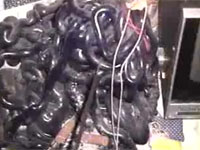 |
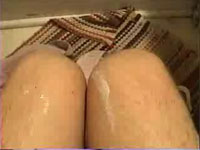 |
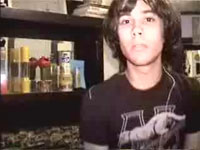 |
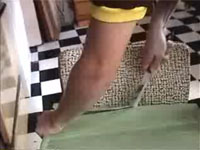 |
|
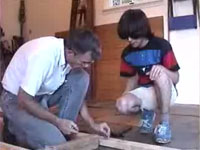 |
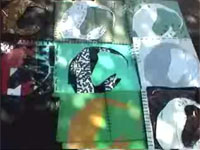 |
|
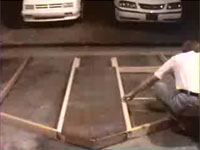 |
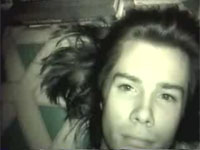 |
.........BACK TO VIDEOGRAPHY